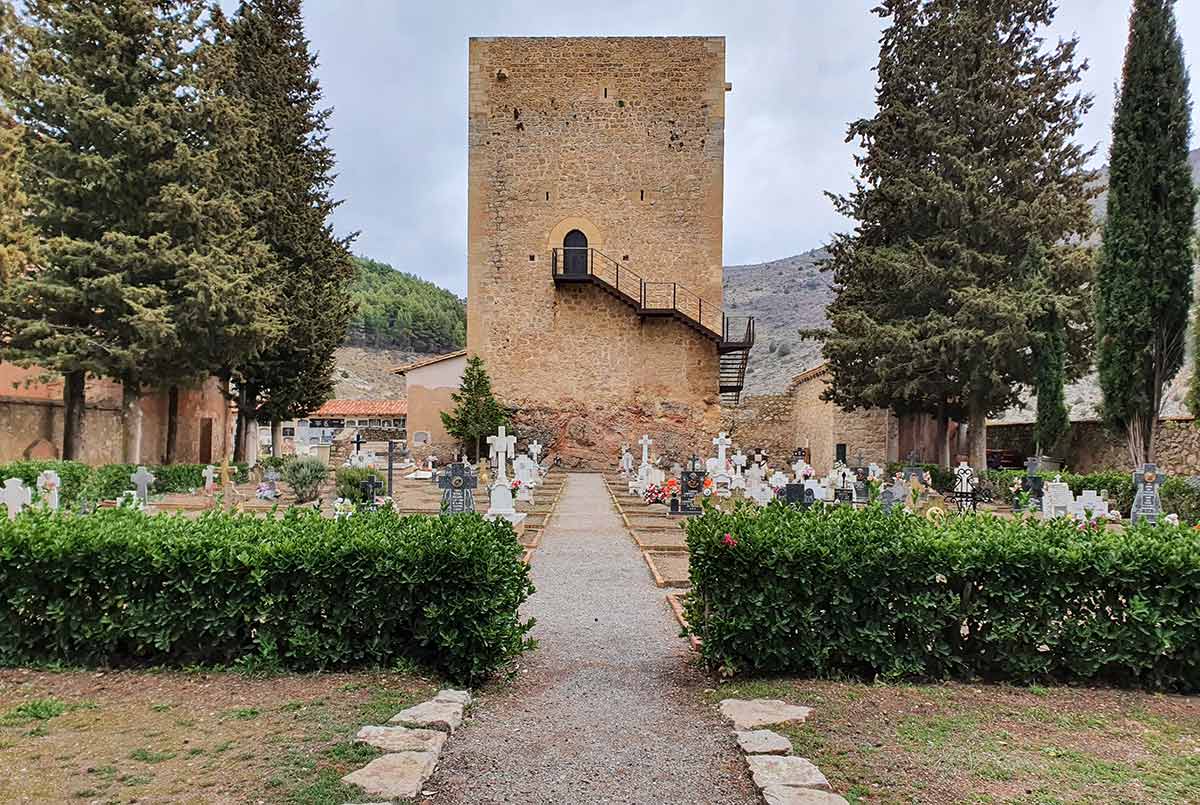Doña Blanca Tower

The Doña Blanca Tower, probably built at the end of the 13th century, is located in the southern or southernmost end of Albarracín, as a watchtower for the sickle that forms the Guadalaviar River and within the walls of the main walled enclosure of the city (9th century). In fact, the tower is considered one of the castles of the defensive system of the city. Its location borders buildings as emblematic as the Church of Santa María, the old Synagogue (Church of San Juan); as well as the ancient ruins of the San Bruno Convent, the Old Hospital – today the Municipal Museum – and the San Juan neighborhood (former Jewish Quarter).
The location of the tower is essential for the defense of Albarracín as it is in the second ring of the city’s defense. With the Muela tower (currently in ruins) and the Andador tower, signals could be made and sent between them, forming a complete defensive system of warnings and communications in times of need.
The tower was built on a stretch of limestone rock and shows carved ashlar corners. Among its stones grouted with lime mortar, pieces of dark-toned metal slag are embedded -which shine with a certain light-, which were recovered in the reconstruction of the tower when pieces of them were found in the vicinity. It should be noted that these metallurgical slag incrustations can also be seen in other sections of the wall.
Its plan is square with just over eleven meters on each side and with walls more than two meters wide. The tower is divided into three floors with a considerable height on each floor and, formerly, it had battlements on top. On the first floor, there is the only access door located more than seven meters high for reasons of defensive strategy. On the second floor, the Aragonese-style crossbows or arrow slits are preserved, one on each side except to the north, which has two. And, finally, and on the third floor there are also crossbows, culminating in the tower with a terrace that served as surveillance and defense and that, at present, constitutes one of the most outstanding viewpoints of the monumental complex.
In the year 1600, the Dominican priests settled in the vicinity of the tower and founded the Convent of San Bruno, requesting its use from King Felipe III and thus being annexed to the aforementioned convent. Later, the tower became the library and archives of the Diocese of Albarracín itself. This space was decorated with pilasters and a hollow vault, leaving the tower abandoned after the dismemberment in 1581 of the Diocese in two: one from Albarracín and the other from Segorbe. In turn, the site of the convent became the current cemetery.
In 2001, a large part of the tower was rebuilt with funds from the Government of Aragon, the Albarracín City Council and other entities. This restoration process was carried out by the Santa María de Albarracín Foundation. In return, the Albarracín City Council ceded it to the aforementioned Foundation and the latter incorporated it as a center or exhibition space within the framework of its “Spaces and treasures” to culturally energize our city.
Finally, and around this majestic watchtower, one of the most beautiful and melancholic stories of the Albarracín mountain range has been forged, the “Leyenda de Doña Blanca”, who was the younger sister of one of the kings of the Crown of Aragon:
Doña Blanca was a princess of extraordinary beauty. So much so that her brother’s wife, the heir to the Crown of Aragon, was jealous of her, since all her eyes were on the young princess. When her brother ascended the throne, Doña Blanca remained at court with her mother, but the new queen would not allow her presence. Some of the great Aragonese nobles advised him to flee to Castile, on the way to its neighboring kingdom. The young woman and her court made a stop in the city of Albarracín, domain of the Azagra family. Her people received her with enthusiasm and she settled in the southernmost tower. After a few days, the inhabitants waited impatiently to see the princess again on her march to Castile. But time passed and the entourage returned to Aragón, but without Doña Blanca. The inhabitants of Albarracín believed that something terrible had happened to her and she would have died, and that she had been buried in one of the towers next to the wall. But no one knew what actually happened. They say that Doña Blanca died of melancholy, imprisoned inside the tower. The inhabitants of Albarracín say that every night of the full moon during the summer, when the bells of the church of Santa María ring at midnight, you can see the figure of a woman who goes down to bathe in the Guadalaviar river. It is the spirit of Doña Blanca, who wanders in grief through the waters of the Guadalaviar.
































